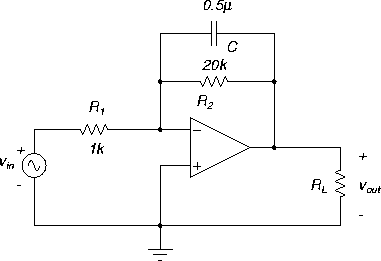 |
Load the PSPICE file activef1.sch, Figure 27.
Lecture Notes: Frequency Response : Active FiltersFor the filter of Figure 27, Z1(s) = R1,
. Then

and so

The DC gain corresponds toand equals in magnitude

The high frequency gain corresponds toand equals in magnitude

The 3dB point is

Exercise:
One decade means a factor of 10, so work out new values of R1, R2 or C to increase f3dB by 10, keeping the DC gain unchanged.
Work out new values of R1, R2 or C to achieve a new DC gain of 10 dB (what is this in the absolute scale?) keeping the 3dB point unchanged.
ANU Engineering - ENGN2211